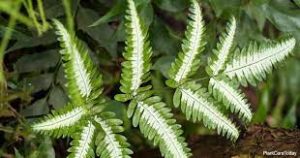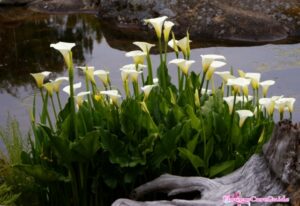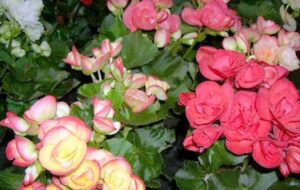With its leaves resembling a pod of jumping dolphins, this lovely string of dolphin succulent will give you beach thoughts all day long! The string of dolphins (Senecio peregrinus) is a trailing succulent in the Asteraceae family that is a hybrid of the string of pearls (Senecio rowleyanus) and the candle plant (Senecio articulatus).
The dolphin-shaped leaves and long hanging tendrils distinguish the string of dolphins. The fragile blooms are quite inconspicuous, so these plants are grown from their interesting foliage rather than their flowers. They look excellent in hanging baskets and vertical gardens, and depending on the aesthetic you want, they can be trained to grow upwards on a trellis or moss pole.
String of dolphins are frequently cultivated as houseplants indoors, but they can also be planted outside. They are not frost-tolerant succulents, though, and require warm temperatures all year to thrive outside.
Succulents with a string of dolphins are often thought to be low-maintenance. Their lush leaves absorb water, making them drought-tolerant, and they don’t require any extra care or maintenance. They’re extremely easy to propagate, so you can easily share some with your friends just by owning one of these succulents.
The string of dolphins is not a low-light plant, and adequate sunlight is required for its growth. This lovely string of dolphins succulent will thrive if you place it in a bright, sunny window and ignore it for the majority of the time. String of dolphins thrives in at least six hours of sunlight every day when grown as a houseplant, despite the fact that it can easily get scorched in direct sunlight when planted outdoors. A south-facing window is preferable, although it can also be cultivated indoors in medium light. Use grow lights to provide more light if necessary.
A string of dolphins, like most succulents, requires arid, well-draining soil. This plant can be grown in commercially available cactus/succulent mixes, but you can also make your own at home. 2 parts potting soil, 1 part pumice or perlite, and 1 part sand are all you need.
As string of dolphins leaves can store water for a long time, they are drought-tolerant and do not need to be watered on a regular basis. To avoid root rot, allow the soil to dry completely between watering and then water deeply. When the plant becomes dormant in the fall and winter, reduce the amount of water it receives.
When cultivated indoors, a string of dolphins grows well in ordinary household temperatures and humidity levels. Surprisingly, while not being frost-tolerant, these plants prefer cooler conditions than the usual string of dolphins succulent. They can withstand temperatures as low as 40 degrees Fahrenheit in the winter (4 degrees Celsius). If you live in a chilly climate, you won’t have to be as cautious about placing your plant near draughty or cold windows as you would with a string of pearls plant.
The string of dolphins does not require fertilisation on a regular basis. Over-fertilizing this plant can actually cause the leaves to lose their distinctive dolphin form. They can, however, benefit from a modest feeding in the early spring to encourage growth and blooming. It is normally recommended to use an organic fertiliser such as worm compost, liquid kelp, or fish emulsion.
String of Dolphin care
Dolphin plants may appear to be simply another novelty plant, but they are picky about how they are cared for. Their growing requirements are identical to those of their parents. Make sure they have plenty of light, although it should be indirect. Allow time for the soil to dry between watering. Plants should be watered once a week during the growing season, but just once a month during the dormant season. String of Dolphin plant care is simple, and the succulent is resistant to pests and diseases. In some climes, spider mites and mealybugs may be a problem. Fungal problems are the most common diseases, which can be avoided with proper watering, well-draining soil, and a container that releases excess moisture.
Aphids, mealybugs, scale, and spider mites, which are common houseplant pests, can be a problem for a string of dolphins. These pests are sap-suckers that can wreak havoc on a healthy plant if left untreated. These common houseplant pests can be readily controlled if caught early and treated properly.
Except for root rot, which is caused by overwatering, these plants are not susceptible to any diseases. You should have no problems if you water only when the soil is absolutely dry, plant it in a container with enough drainage holes, and use a well-draining soil mix.
When exposed to too much sun, the String of Dolphins, like the String of Pearls, can easily become burnt. Because they are not heat-loving succulents, avoid exposing plants to direct sunlight when the weather is hot. If you wish to put them outside with your other plant collections, put them in a shaded area where they will get indirect or filtered sunlight throughout the day. They are frequently grown in zone 10, and so are not cold-hardy.
If you’re going to grow them as a houseplant, make sure you put them in a south-facing window where they’ll get at least 6 hours of morning sunlight each day. During the winter, you can also put them under a T-5 fluorescent or LED Grow Light.
String of Dolphins, unlike other succulents, prefers chilly air and can endure temperatures as low as 40 degrees Fahrenheit in the winter. It is optimal for them to have a temperature of 72 degrees Fahrenheit throughout the summer months or during their growing season.
Keep in mind, however, that the String of Dolphins is a “soft succulent,” which means it will not survive a harsh freeze so that must be taken care of.
How to propagate string of dolphins
Propagating string of Dolphins can be done easily in water or soil via stem cuttings. For the greatest results, choose cuttings with at least 2-3 nodes along the stem. The nodes are located where the leaves emerge from the stems and where the new roots will grow. Remove the leaves from the lowest node or two if you’re propagating stem cuttings in water to keep them from rotting. Within a few weeks, roots should emerge, at which point you can transplant the cutting to the soil. If you’re only propagating in soil, simply place the stem cutting on top of the soil and keep it moist until roots emerge. String of Dolphins propagation extends across the ground or grows down from a hanging container as it matures. When given ample light, it grows well inside. Each dolphin-shaped leaf acts as a “window,” absorbing light. Senecio rowleyanus “String of Pearls” and Senecio articulatus “Candle Plant” are hybridised to create the String of Dolphins bloom.



